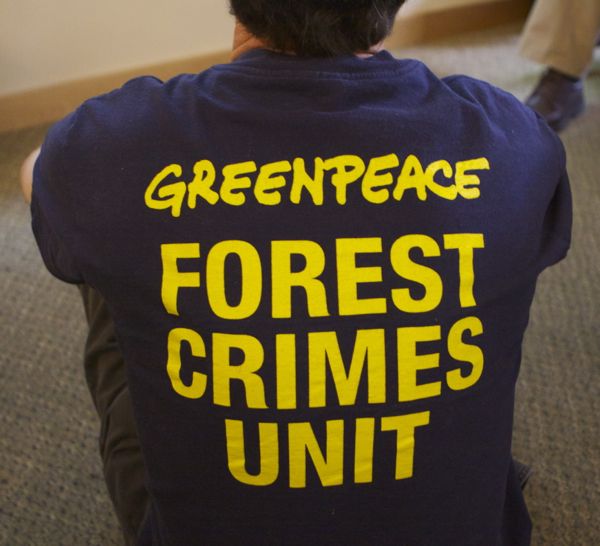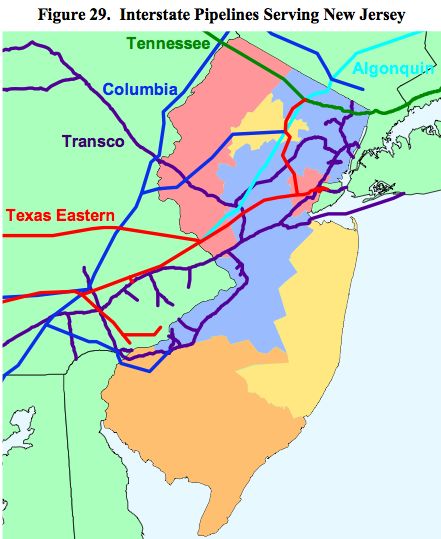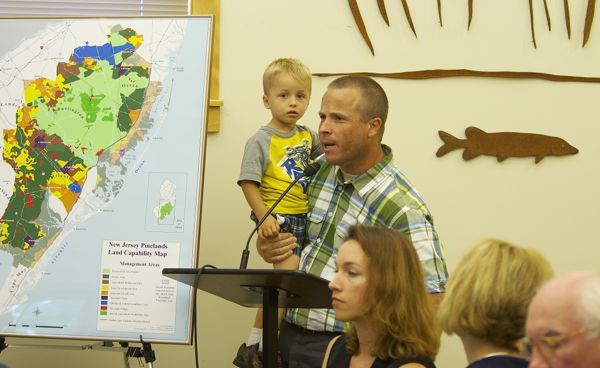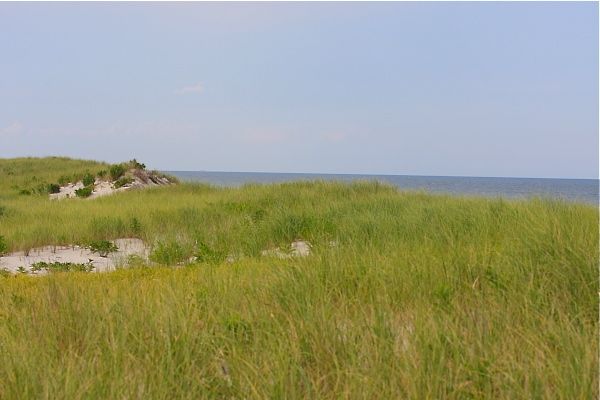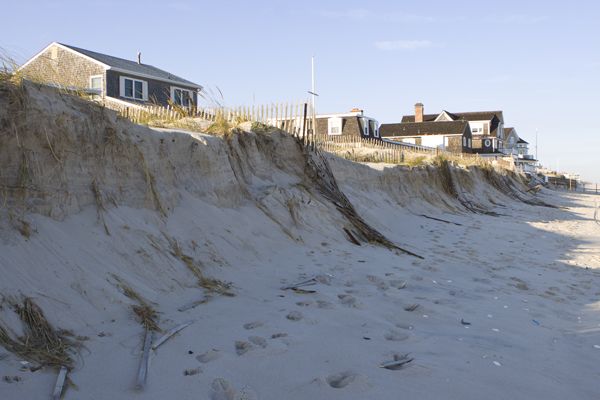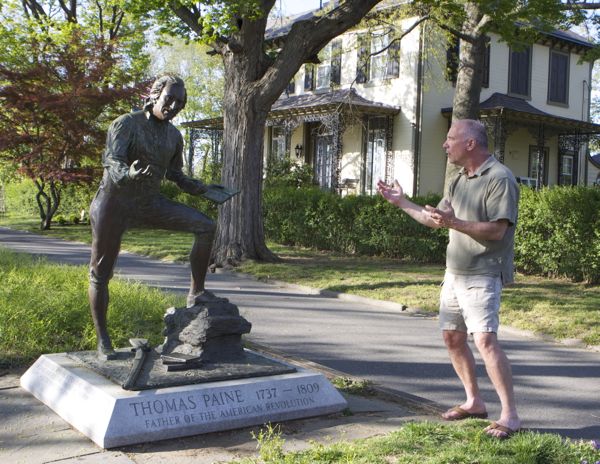Gas Pipeline Through the Pines – It’s Chinatown
Proposal Based on Gov. Christie’s Energy Master Plan Promotion of Gas
Another Fracking Christie Legacy and Another Huge Missed Opportunity for Renewables
Test of of the Pinelands Commission’s Integrity and Independence:
“Would you risk the public’s water supply for a business deal?”
“If you say ‘Yes’ to this, what can you say ‘No’ to?”
[Updates below and in text]
At the conclusion of the meeting, I asked a series of questions of Counselor Roth, forcing her to admit that the Commission had no science, no standards, no criteria, no methodology, no policy, no technical Guidance, and no review procedures for an “equivalence” or “offset” demonstration.
I suggested that perhaps work on developing and adopting a science based offset policy should preceed an ad hoc review of the pipeline project. ~~~ Bill Wolfe
When I recently heard of a proposal to build a $65 million 22 mile private gas pipeline through the Pinelands National Reserve to [spend $400 million] to [convert] re-power the B.L. England coal power plant [to natural gas], I thought it was some kind of April Fools joke – or Onion story.
[Update: according to South Jersey Gas (SJG), the pipeline cost is now $90 million, a huge increase from prior estimate. Final costs likely to be even higher.
Also take a look at the arrogance of SJG, in this April 29, 2013 press release touting BPU approval, which, according to SJG, “Enables the Natural Gas Conversion of the BL England Electric Generation Plant to Proceed.”
No mention of the Pinelands Commission!
Aditionally, this statement about the capacity of the project is inconsistent with the BPU presentation, which implied that the pipeline would provide backup fro 63,000 customers, not 267,000!
Once online, the annual throughput of gas to the BL England facility will be about 20 million dekatherms, essentially equal to the amount of gas SJG currently provides to approximately 267,000 homes in a year. The plant is expected to begin operating in 2016. – end update.]
So, without having read the documents, I had to go down to the Pinelands Commission meeting yesterday to hear about the proposal (good news, if I can call it that, is that the route appears to follow existing road right of way – but it was not made clear how much forest disturbance would result – see PPA analysis linked below).
Sure enough it’s real – or should I say surreal.
I kept expecting to see Jack Nicholson escorted out of the hearing: “Forget it Jake, its Chinatown” (watch that famous scene).
Because this one is Chinatown – its all about money, politics, and installing energy infrastructure to fuel more fossil power and drive coastal development.
A boondoggle again paid for by the ratepayers.
By their own words, the Christie Administration is about to make another huge energy policy blunder – at the expense of the Pinelands and the integrity of the so called “independent” Pinelands Commission – by making political commitments and huge investments of ratepayer money in fossil fuel infrastructure – all while denying climate change and missing a huge opportunity to shift direction to renewable power.
Only the Pinelands Commission can stop it.
Part One: Upside down Energy Policy – BPU as an arm of the Gov.’s Office
The representative of the Board of Public Utilities (BPU) spoke and responded to the Commission’s questions for almost 2 hours and made the policy and politics driving this pipeline abundantly clear (the BPU spokesman and lawyer arrogantly walked out and left after their marathon, before listening or responding to public comments, which prompted loud angry denunciations from the crowd).
The BL England part of the story began with DEP’s 2006 enforcement order that required shut down of the B.L. England Beesely’s Point coal and oil fired power plant for longstanding serious failure to meet air pollution standards and comply with pollution control requirements for NOx, SOx, mercury, and fine particulates.
That original 2006 DEP shut down Order was based on traditional air pollutants, not greenhouse gas emissions.
But it did include an option, under certain conditions, for the plant to be re-powered. But, at the time it was issued, the expectation was that the plant would close. Plant closure was opposed by local officials and south jersey legislators. And certainly, there was no mention under the original DEP Order of re-powering the plant with Marcellus shale fracked gas from a 22 mile pipeline through the Pinelands National Reserve.
But now, in a stunningly hypocritical move, the anti-regulatory, anti-enforcement Christie DEP is spinning to take credit for the air quality benefits of the 2006 Enforcement Order. But at the same time, DEP has refused to enforce it, extended its deadlines, and renegotiated the original 2006 Order last year to pave the way for re-powering and Pinelands pipeline.
Worse, ironically they are using a DEP enforcement Order that sought to protect air quality, to be the vehicle to drive a dirty fossil re-powering deal, with dirty fracked gas, via a new pipeline through one of the most environmentally significant places in the state, a national treasure.
[I didn’t fully realize that paragraph #20 of the Christie DEP revised Order mandates re-powering – thereby using regulatory enforcement to drive corporate profits and assure BPU approval (i.e. BPU virtually must approve cost recovery for expenditures to comply with DEP mandates). The new Christie DEP Order also virtually promises that DEP will approve permits for repowering too, all prior to ANY public review.]
On top of all that, it was a stringent, nationally leading 2004 DEP mercury emission rule that led to that 2006 Order, a rule adopted under the McGreevey administration (to read the 2006 Order, hit link and scroll to page 37, sorry, this is the only place I could find a copy!).
[Note to readers: Gov. Christie ended NJ’s national environmental and regulatory leadership under Executive Order #2 (“regulatory relief”) and as a result, the Christie DEP has done nothing on the regulatory front. So it is remarkable hypocrisy for them to take credit for the 2006 closure Order, particularly so when they are using it to drive a dirty re-powering private pipeline deal.]
A self congratulatory DEP press release ignores all this and just says his:
One of the New Jersey’s oldest power plants, B.L. England in Cape May County, will significantly reduce air pollutants by shutting down one of its coal-fired units and converting two others to clean-burning natural gas, steps that will significantly improve air quality while ensuring continued energy reliability for the southern shore region, Commissioner Bob Martin announced today.
While ignoring this DEP enforcement history and violations by BL England, the BPU representative’s presentation was astonishing.
He began by noting that the Board had issued 2 Orders already this year, approving the pipeline project. These approvals were issued without consultation or participation of the Pinelands Commission (or the public).
Although there are conditions of these BPU approvals that require that the project receive all other permits and approvals, its Chinatown – it was clear that the deal is done.
To emphasize to the Commission just how done this deal is, the BPU spokesman explicitly linked the Board’s approvals to Gov. Christie’s policy initiatives, expressly making this pipeline a Christie legacy.
In a revealing and extensive statement, BPU said that the project was approved by the BPU because it was consistent with Gov. Christie 2011 Energy Master Plan policy that promotes in-state gas fueled generation capacity and expansion of natural gas pipeline infrastructure, especially for South Jersey.
Despite strong opposition by environmental groups to the Gov.’s Energy Master Plan, Commissioner Ashum and others seemed unaware of the Gov.’s pro-gas energy policy and asked questions about it. So, here it is, read it and weep:
The pipelines that serve New Jersey benefit from increased production by the Marcellus Shale region. Existing pipeline connections allow for the transportation of shale gas from Marcellus in addition to conventional production from the Gulf Coast. Shale gas is expected to increase substantially in the decade ahead, and may continue to capture increased market share for decades. There are a number of competing new pipeline proposals that are expected to expand pipeline deliverability into New Jersey and the New York metropolitan area, which would provide Marcellus Shale gas producers with improved access to these markets. New Jersey’s pipeline and LDC infrastructure is likely to be strengthened by these new pipelines. The Christie Administration seeks to leverage New Jersey’s natural gas infrastructure to foster the State’s environmental and economic goals. (@ p. 58)
1) BPU admitted that BPU has no regulatory authority over “merchant” generation facilities, no requirement that they demonstrate a need, and consideration of energy alternatives. Merchant generators sought and were driven by profits, not sound energy policy and BPU had no role or power in any of that under energy deregulation. Left unsaid was that this market chaos is the legacy of Christie Whitman’s energy deregulation legislative initiative.
2) BPU never once mentioned consideration of renewable energy or the impact of the BL England plant fueled by low cost fracking gas on the investment or economics of renewable power;
3) BPU enver once mentioned greenhouse gas emissions and climate change;
4) BPU held out a fig leaf by concluding the project was justified by the need for “reliability” and redundancy in the south jersey gas infrastructure supply. This surprised the Commissioners, who thought that the pipeline would be dedicated exclusively to the B.L. England power plant.
5) The pipeline is an intra-state pipeline under the control of NJ state officials. This is very different from the north jersey gas pipelines, which are under FERC jurisdiction and FERC can pre-empt any NJ efforts to block them. In fact, DEP has held out the possibility of FERC preemption as an excuse for sweetheart State land lease deals and rubber stamped land use pemits DEP issued.
The BPU spokesman made a series of contradictory, questionable and/or vague assertions on several important issues and unknowns regarding the capacity the 24 inch pipeline; how that capacity was allocated; how it was paid for; how it could enhance “reliability” for 63,000 gas users in Cape May; and why, if this “reliability” was so critical, the BPU had not mandated that South Jersey Gas Co. install it years ago.
Part Two: Pinelands Commission on the Hot Seat:
- What does “equivalent protection” mean?
- Is an “offset”, a political deal or a science based public policy?
- Just Say No to MOA!
Before I make a few observations, see the Pinelands Preservation Alliance analysis and news coverage of the meeting (and take a look at the happy faces of Commissioners and staff):
- Plan to put gas pipeline in Pinelands spurs ire
- Proposed 22-mile Pinelands gas line draws opposition
As usual, Kirk Moore of the Asbury Park Press has seen this all before and smells the dirty deal in the works. Kirk frames the core question before the Commission:
New pipelines are not a normally permitted use in the commission’s forest area zoning, and the 24-inch diameter pipeline would go underground for 14 miles through the forest alongside Route 49, from Millville to Tuckahoe. […]
The Pinelands board is facing a situation not unlike when it granted permits for Conectic (sic) to build a power line west of the Garden State Parkway in southern Ocean County, and as part of the agreement got $13 million from the power company to buy land for preservation. Such “offsets” could be part of any agreement on the natural gas line, but “we’re not prepared to discuss that,” said Stacey Roth, a lawyer for the commission.
The Commission lawyer acknowledged the possibility of approving the pipeline project under an Memorandum of Agreement (MOA) with the Board of Public Utilities (BPU):
Under normal circumstances, the Pinelands Commission expects that a public agency’s development plans will conform to all of the land use [N.J.A.C. 7:50, Subchapter 5] and development standards [N.J.A.C. 7:50, Subchapter 6] of the Pinelands Comprehensive Management Plan [CMP]. However, there may be instances where a public agency believes that a specific development plan can not conform to all of the CMP’s requirements.
Although the Pinelands Commission expects these types of situations to be very rare, the CMP [N.J.A.C. 7:50 – 4.52 (c)] does allow the Commission to enter into an intergovernmental agreement that authorizes a public agency to undertake development activities that are not fully consistent with Pinelands land use and development standards.
But, under Commission regulations, a MOA is limited to public agencies – as Commissioner Ed Lloyd noted during the meeting when he questioned Ms. Roth on how the BPU could be considered the applicant, when the pipeline was a project initiated by a private energy company, South Jersey Gas.
Because the pipeline is not consistent with the Comprensive Management Plan (CMP), if approved, the project would have to demonstrate an “equivalent level of protection” as provided under the regulations, a concept the Commission implements via “offsets” (this is sometimes referred to as “mitigation”.)
At the conclusion of the meeting, I asked a series of questions of Counselor Roth, forcing her to admit that the Commission had no science, no standards, no criteria, no methodology, no policy, no technical Guidance, and no review procedures for an “equivalence” or “offset” demonstration.
I suggested that perhaps work on developing and adopting a science based offset policy should preceed an ad hoc review of the pipeline project.
During my testimony, I questioned the trustworthiness of pipeline company engineers and mentioned some of the risks of pipelines in light of recent problems in Vernon, and the washout that destroyed Lake Lookover, and sinkhole collapses in Montague and Louisiana.
But I forgot to mention tis little bit of humor by South Jersey Gas presentation about gas pipleine safety, which I’ll close with: NJ Natural Gas “Resiliency Strategy”:
Natural gas infrastructure is underground and protected

Commissioner Ashmum - longtime member, reappointed by Christie. Will she allow a pipeline deal to taint her legacy?
Right.
A 19 year old young man, studying economics, posed the real question:
Would you risk the public’s water supply for a business deal?
His question was followed up on by the final commenter of the day, who had the shortest comment of the day – she asked in full:
If you say Yes to this, what can you say no to?
[Update: Curiously, South Jersey Gas Co. engineers concluded that horizontal directional drilling under Great Egg Harbor would pose unacceptable risks – someone should tell DEP this, because DEP is allowing drilling under the Wanaque Reservoir!
